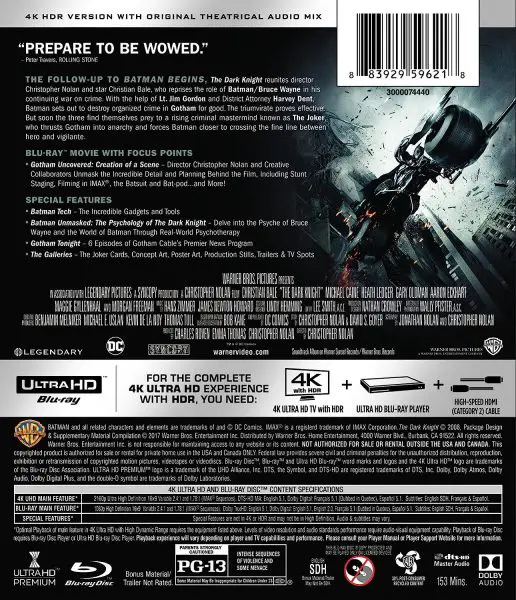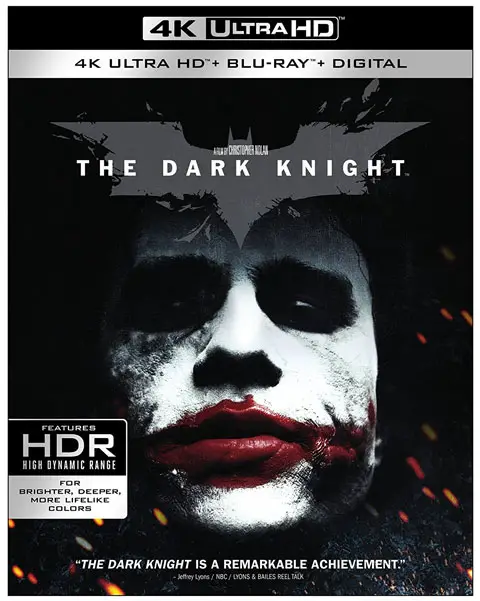
Warner Bros. Home Entertainment released this edition of The Dark Knight (2008) on 4k Ultra HD Blu-ray on December 17, 2024. The 3-disc edition includes the film on 4k Blu-ray and Blu-ray, as well as a bonus Blu-ray Disc with special features. The 4k Blu-ray includes the original theatrical audio mix. Let’s take a look at the 4k presentation that includes a review of the film itself from a review of the originally released Blu-ray.
The Specs
The Dark Knight on 4k Ultra HD Blu-ray is presented in 2160p resolution (4x the resolution of 1080p Blu-ray) with variable aspect ratios between 2.4:1 and 1.78:1 (IMAX sequences). The video also features enhanced color and contrast via the HDR10 specification (viewable on supporting 4k HDR TVs). And, audio is provided in DTS-HD Master Audio 5.1 (English) along with subtitles in English SDH, French, and Spanish.
The New 4k Remaster
Director Christopher Nolan personally oversaw the remastering of ‘The Dark Knight’ trilogy films for 4k release, proclaiming that if you can’t watch the movies in the theater the Ultra HD Blu-ray releases are the closest thing you can get at home, with deeper color palettes that more closely match the analog colors of the 35mm film.
“Photochemically finished films of 35 millimeters have at least 6K resolution, IMAX films upwards of 18K, and so as home video formats keep evolving, 4K — particularly with HDR — allows us to give somebody in the home an experience that’s much much closer to what it was like to see the original film prints as projected on film,” the director told BadTaste.it. (See the YouTube interview here).
And it’s true. We first popped in the 1080p Blu-ray of The Dark Knight to compare to the new 4k Ultra HD Blu-ray release and it renders far superior color range. The darker areas and shadows have a ton more detail, and, there is much more contrast between light and dark areas. Of course, make sure your TV is set to cinema mode and not one of those fake, color-enhancing modes that make films look more like cheap TV shows than the multi-million dollar productions they are.
The soundtrack is still formatted in DTS-HD Master Audio 5.1 like the original 2012 Blu-ray release, and matches the mix of the theatrical version. But, it likely went through a bit of cleanup for this new print because it sounds a bit louder overall and LFEs (low frequency effects) seem to be even more effective in the subwoofer range. Nolan has been known for a frontal approach to audio and so you may never see his films getting an Atmos track, although rear speakers are engaged when needed. But, for what it’s worth Nolan’s movies provide some of the most powerful audio experiences for your home theater and The Dark Knight is one of them.
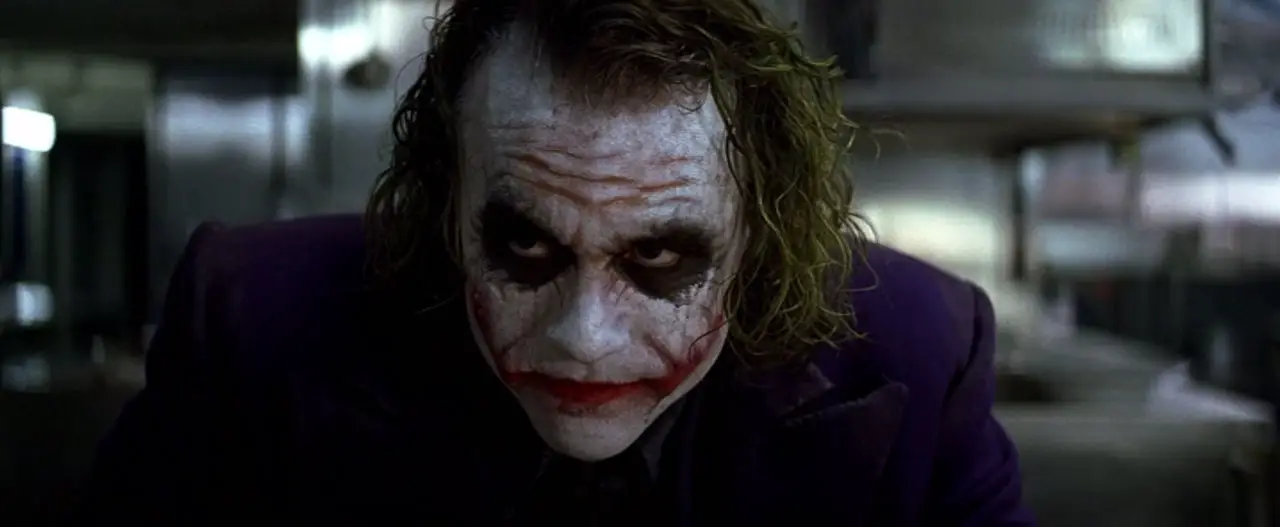
The Film
What more can be said about Christopher Nolan’s superb sequel to his reboot of the Batman franchise: Batman Begins? The mere fact that it was already much improved over the first film, a fine comic book movie in its own right, was enough to make fans and fanboys alike eager to see it, but when word leaked of a powerhouse performance, as opposed to some new, cool special effect, from Heath Ledger as the Joker (a role previously assayed by Jack Nicholson in classic form), fan and general audience anticipation rose to a fevered pitch…and that was before Ledger tragically died, having completed all his scenes for the film. After news of his death, the expectations for the 2008 Warner Bros. release ratcheted up to such lofty levels that had the film not lived up to the hype, even if it had been just simply a great comic book movie, it would probably not have become a huge worldwide hit, and certainly would not have become the darling of both audiences and critics, riding a wave of respectability as a highly regarded piece of filmmaking. Instead, the hype proved justified and Ledger’s outstanding turn as one of the most iconic villains in comics was hailed as a significant achievement that culminated in a well-deserved, posthumous Academy Award for best-supporting actor and helped raise The Dark Knight far above other films of its ilk.
The Dark Knight is an incredible film in no small part due to Ledger’s sly and savage Joker, but his twisted, malefic presence is not the film’s only highlight. The rest of the cast makes worthy and notable contributions to the film, and with terrific performances from Gary Oldman, Michael Caine and Christian Bale, the film offers some seriously solid acting chops.
As it would be almost too easy to hand the focal point of the film over to the Joker’s arch antics, it’s up to Nolan to rein that impulse in and use the Joker as sparingly as possible. Nolan seemed aware from the start that it is Bale’s conflicted Batman that must remain the focus of the film, becoming a symbol of vigilante justice that is perceived as both a dangerous public nuisance and a necessary crime-fighting icon for Gotham City’s renewal. Bale nails it in a winning turn as the Caped Crusader, and though the low grumble of his non-tech bat-voice becomes an irritant at times, he has a humor about him (on camera at least) that allows Bruce Wayne to be, by turns, coy and lighthearted even when Wayne’s trust-fund-kid churlishness comes to the fore. It would have been simple to take the broad, whacky approach to the role, but Bale never does, and he gives his Batman a realistic, rough-hewn edge that’s very much in touch with Wayne’s tragic past. He acquits himself expertly in and out of costume and in a way that Michael Keaton’s take on the character often lacked, though the humor was definitely there in Keaton’s interpretation.
Taking place immediately after the events of the first film, Batman has upped the ante by taking on the criminal underworld in violent (but often non-lethal) fashion. Gotham’s organized crime lords and their minions are now on the run and unable to do business, but because he’s escalated the stakes and has the mob is on the ropes, they are now ready to do anything to get back to business and start raking in the dough. While the very idea of “the Batman” meting out justice has turned the tables on criminals and inspired the public to rise up against crime and corruption (with some becoming mock Batmen… using guns and bullets instead of wits and fists) the theme of ever-widening violence for control of the city discussed at the end of Batman Begins is now taking its toll on Bruce Wayne.
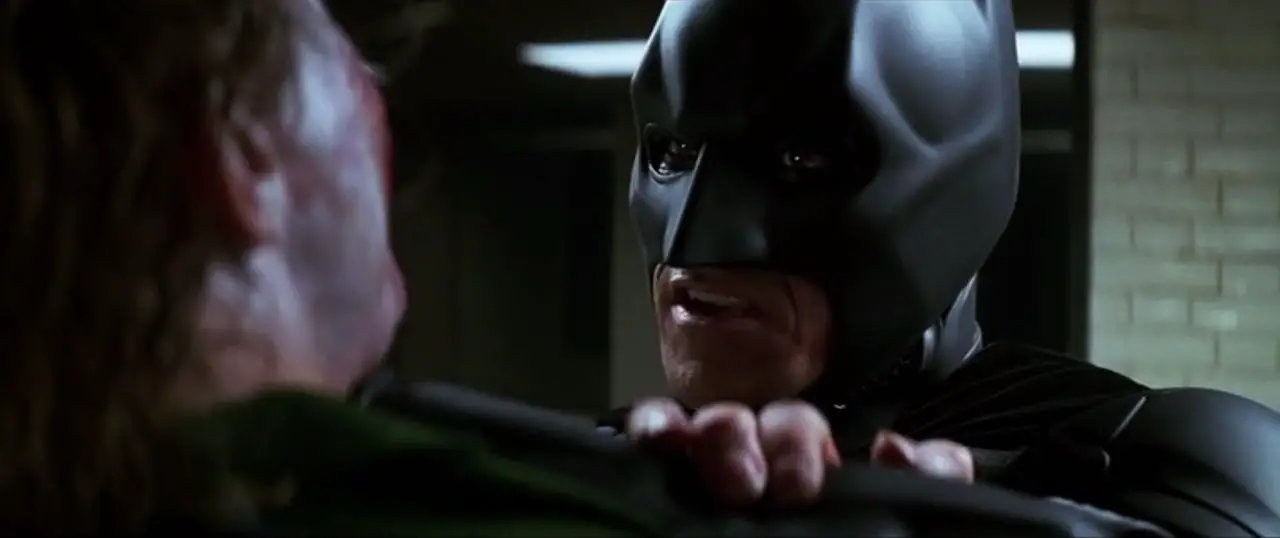
Aside from the constant abuse to his well-honed body, he fears for the safety of those around him, and as Batman becomes his primary identity he allows the man known as Bruce Wayne to become a caricature of the playboy billionaire… a mask to show the outside world, a façade to protect those he loves, and the only way to maintain Wayne Industries and allow himself the time (and money) to be the kind of (Bat)man he needs to be. The only question remaining is which Batman does Gotham want: A dark vigilante protecting them from terror? A useful myth on which to pin their own fears and darkest hatreds? That question is the dark heart of the matter.
The perfect villain to test Batman’s devotion to the city, and vice versa, is the Joker. The clown prince of crime is a mockery of everything that Batman stands for, almost an inversion of his self. Batman comes to fear that he’s more Joker on the inside than Bruce Wayne, and the Joker perfectly understands this… he’s determined to exploit Batman’s dual-nature for no other reason than it’s fun to mess with him and what he stands for. Representative of utter chaos, playing havoc with Batman’s own ruthless quest for civilized order, he has no plan of his own, but is bent on proving to Batman the error of his own deeply held philosophy and mission. The Joker is the price that is paid for attempting to rid the city of crime… and once he’s hired by the Mob to exterminate their bat problem, there’s nothing much to stop him from letting Batman live while biting the criminal hand that feeds him. Batman finds out the hard way that it’s not money or power that motivates the Joker to conduct his experiments in social destruction… he’s just having a darned good time being the inchoate lynchpin for further hysteria and disunity. It’s his job, he’s good at it, but he doesn’t take it that seriously and has no plan in place… The Joker represents the mask pure bedlam puts on when going out and strutting about the town to have a good laugh at the expense of others, or as he himself says: “I’m a dog chasing cars. I wouldn’t know what to do with one if I caught it.”
It’s easy to review the excellent action set-pieces and high-tech toys (love that Batpod!), which are indeed truly exciting and jaw-dropping, but for the most part, it’s the performances that make this a most unusual, and highly successful comic book adaptation. The caliber of the cast is what allows The Dark Knight to elevate itself from other big summer franchises, turning what could easily just been a vapid blockbuster geared toward teenagers into something richer and more satisfying. Nolan has a lot more on his mind than just action and excitement at blowing stuff up on a big screen, and he proves this repeatedly by letting the well-written script by his brother, Jonathan (with story help from David Goyer), breathe with excellently paced sequences while letting the actors also stretch a bit in their roles.
Only Maggie Gyllenhaal’s Rachel Dawes leaves much to be desired. While the character always seemed from Batman Begins to be a rather simple plot-device— the moral conscience of the film who turns Bruce Wayne away from personal murderous vengeance toward a larger crusade on behalf of justice— in the sequel she’s become the typical damsel in distress and not much more. While Katie Holmes played the role in the first film and was quite underwhelming (did anyone believe for a second that she was a top-notch litigator in Gotham’s DA’s office?), poor Gyllenhaal, who’s done better (see Sherrybaby), can’t seem to lift the character out of the cinematic ghetto where most female characters tend to reside come summertime at the movies. The comics themselves offer captivating female characters, it’s a shame comic book movies can’t seem to do the same. On the other hand, in what could have easily been a menial role, Michael Caine broadens his multi-faceted take on Alfred Pennyworth and becomes Bruce/Batman’s moral sounding board for when the chips are down or the crime-fighting life just gets plain confusing. It is Alfred who understands just what the Joker is all about, and he capably warns his master from being consumed in attempting to capture such a completely irrational psychopath.
Not to be outdone, Morgan Freeman’s easygoing gravitas is on full display as the urbane and humane Lucius Fox, a man who remains deeply conflicted in his allegiance to vigilante justice but just can’t help devising new ways for Batman to outwit his opponents. Gary Oldman continues to be his awesome self and is perfectly cast as Jim Gordon. The epitome of Gotham’s finest, Gordon moves quickly through the ranks, becoming Commissioner under the most dire of circumstances. Oldman underplays the role to perfection, never allowing the over-the-top-Oldman of past performances to leech into the character. He grounds Jim in reality as a family man who takes his job seriously and wants to lift Gotham from the quagmire of corruption into which it constantly threatens to sink.
His story threatens to become tragic, yet the true tragedy of The Dark Knight is what becomes of Harvey Dent, Gotham’s White Knight District Attorney who’s out to put the Mob out of business forever. He’s the wildcard in Joker’s hand, and proof of the concept that all it takes is one good push in the right direction to turn a man into a monster capable of doing harm to others and even himself. Dent, played by noble, squared-jawed Aaron Eckhart, is known as “Two-Faced” Dent by other cops for actively investigating corruption within the department as well as hammering away at the Mob and exposing their money trail. Eckhart plays him as a dangerous man with Kennedyesque confidence; a capable man with political ambition and a touch of hubris, who’s unwilling to accept the amorality that surrounds him. He’s a guy willing to put his life on the line and step up to the plate when the public screams to have Batman’s wings clipped. It’s an astonishing turn… Eckhart is more than willing to show Dent as deeply angry man attempting to keep his more despotic impulses in check, while creating enough sympathy for him that when his coin of chance flips unfavorably, we’re still with him enough to care and feel regret for what he’s become.
Nolan does a helluva job in keeping his major vision for Batman intact, creating a seriously plausible environment in which Batman can realistically exist. His ploy is to portray Batman as a vigilante with unlimited resources and a fashion fetish who becomes the great symbol of Gotham City’s soul. While Batman Begins still had some claustrophobic set-design reminiscent of the Tim Burton style manual with the model work of the Narrows (Gotham’s slum) on prominent display for most of that film, Nolan seems to have finally gained Warner’s confidence in bringing Batman more fully into real-world environments. With his use of IMAX cinematography, Nolan’s take on Gotham is suddenly unbound by the visual constraints of models and sets. Without resorting to CGI landscapes he uses Chicago’s natural cityscape and imagery to broaden the scope of the picture and Batman’s place in the world.
As Batman has no jurisdiction over his crime-fighting efforts, it seems quite reasonable that he would go to Hong Kong to nab a suspect… and it’s a wonderful touch that doesn’t pull the viewer out of Batman’s fictional world. Nolan allows Batman/Bruce Wayne to actually do some detective work (which, if you know the comics, detecting crime is Batman’s actual vocation, though he’s not on the city payroll), and while that’s not a cinematic first for the character… I remember Michael Keaton’s crime-fighter doing much the same in Burton’s first Batman film as he attempted to discover what Smilex actually was… it clearly aligns Nolan’s Dark Knight with that of the comics and provides Batman some dimensionality that, as a cinematic character, he often lacks.
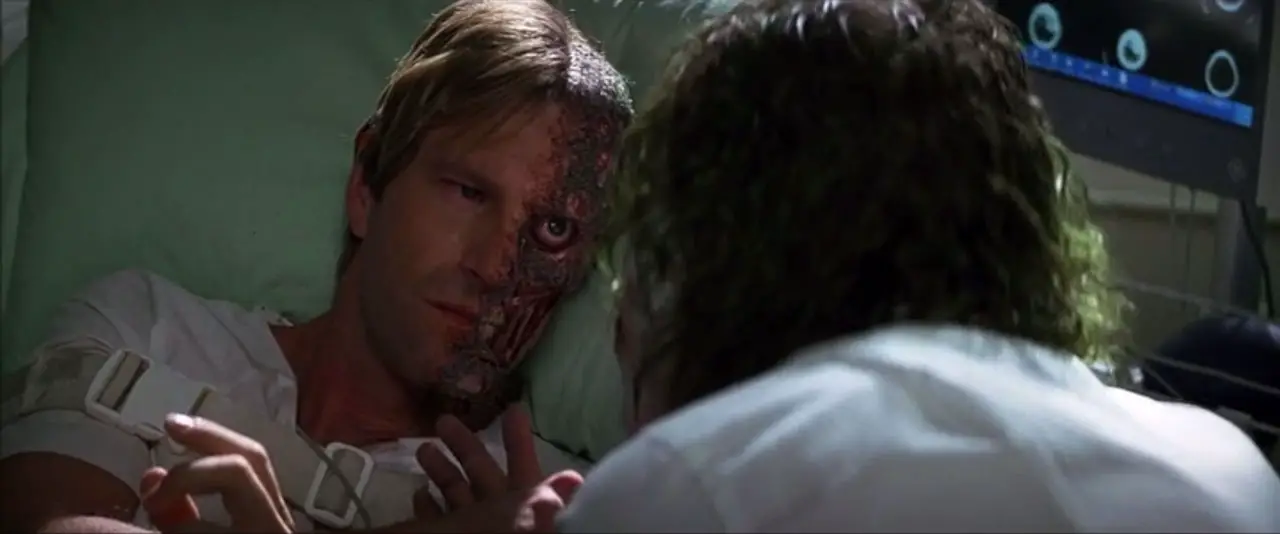
At the time of release it was the third-highest grossing movie of all-time in the US (barring inflation). Most folks should know the plot details, but if you don’t then you clearly need to get out and get a copy of the 4k Blu-ray edition… it’s virtually the only way to see this amazing-looking film as was intended, though your best option is still in theaters (should it ever be re-released in IMAX, but that’s doubtful at best). Nolan and ace cinematographer Wally Pfister shot several sequences, including the stunning opening bank heist sequence, using 70mm IMAX cameras. Using a large, unwieldy camera that shoots only two minutes worth of large-format film and was designed for shooting natural vistas, Nolan and team have taken the IMAX format to some amazing extremes (as if the extremes of space where not enough). Using special mounting rigs, Nolan and Pfister achieve what was formerly thought impossible… using an IMAX camera as if it were a handheld for action scenes and getting in as close and tight as possible during an amazing car/truck/Batpod chase sequence. Nolan is no fan of CGI and took a practical-effects approach to The Dark Knight which makes a truck flipping over end-over-end a real treat for the eye. Nolan’s approach lends The Dark Knight an air of realism that places the film alongside the best cinematic crime dramas and easily transcends its comic book origins.
While Sam Raimi had done wonders with the Spiderman franchise, he still worked in a colorful CGI comic book world where reality is malleable depending on the story’s needs. Nolan’s effort is grittier and more life-like, more like watching a 70s-styled heist film than a comic book movie, and while much has been said about the Michael Mann and Sidney Lumet influences on the movie, Nolan takes that inspiration and gives it an operatic quality… turning what could have been marginal action sequences into jaw-dropping showstoppers (that are so well integrated that they don’t really stop the show at all, but serve to propel the narrative quickly and without much drag). In the end, some of the best special effects of all are simply Ledger performing the Joker’s dialogue or Nolan’s precise and methodical way of filming a bank hold-up. You don’t need CGI for that, and it makes the film completely re-watchable… a timeless piece of cinematic brilliance bordering on a masterpiece.
On Ultra HD Blu-ray we’re offered a terrific remastering of the film and those stunning IMAX sequences, as well as some Blu-ray specific features (only offered in 1080p). Still, a commentary would have been excellent, too. Ultimately, the best reason to own this disc is to have a seriously great reference disc on hand for the impressive video and audio quality. Warner Bros. generally does an excellent job with many of their top-tier 4k Blu-ray titles (the hits for the most part) and The Dark Knight looks and sounds terrific. The best part is that those amazing scenes Nolan filmed in IMAX look jaw-dropping on a big living-room screen in 4k. To accomplish a kind of quasi-IMAX effect at home the widescreen image switches aspect ratio, nearly imperceptibly, between 16:9 for the IMAX scenes (originally in 1.44:1 ratio) and 2.4:1 with small letterbox bars at top and bottom for the similar aspect ratio size of the projected 35mm scenes. The switch (six times for each IMAX scene) is not as distracting as one might think, and overall it’s a huge benefit to the presentation of the film.

I had seen the IMAX Experience version of The Dark Knight during its theatrical run and came away impressed by those eyeball-melting sequences especially the key opening heist sequence. On 4k Blu-ray the stunning theatrical IMAX presentation looks phenomenal… every bit of detail is there, tack-sharp without any over-processing of the image due to transfer. I feared distracting moiré patterns as the camera swept past the narrow windows of Chicago’s skyscrapers, but that video defect, normally seen in standard DVD transfers and televised standard-def video, but also seen in poor transfers to higher definition formats, is simply not apparent in this transfer… the VC-1/1080p image holds steady during playback and on the eye there is never any lack of clear detail. Color saturation is perfectly timed with deep black levels throughout.
Edge enhancement, and there is a noticeable amount of edge enhancement and DNR during the 35mm scenes, is mostly apparent during dimly or softly lit sequences. However, and I must stress this, there is none of that awful haloing or cheesiness that marred Paramount’s Sapphire Series release of Gladiator (on the extreme of examples, sure, but still). Overall digital scrubbing is only slightly apparent on The Dark Knight, and should be a moot point in any buying consideration. It is evident that Warners/Nolan took steps to make the 35mm image as clear and sharp in high-def as the IMAX scenes are. Bottom line: the video, whether during IMAX scenes or standard widescreen, is always of top quality and playback offered nothing less than a pleasurable experience throughout.
Audio quality is on par with the image, with True HD 5.1 offering lossless playback. Low frequencies were impressive, as Batman films often feature that deep rumble of the Batmobile’s engine (or Christian Bale’s Batvoice), but just as joyous on the ears was the variable whine of the Batpod on the mid- and high-ranges. Surround channels are featured to great effect during the superb chase sequence on Chi-town’s famed Lower Wacker Drive, giving a sense of place and action. Yet the audio also captures the quieter ambient sequences important to The Dark Knight’s more realistic setting. Most impressive is the handling of the soundtrack, especially the creepy Joker theme where two discordant notes are played like razor blades on a fretboard. Needless to say, through a top-end home system that aural effect creeps up on you and tingles the spine. Just as good for lower-end systems is the standard DD 5.1 mix (English, French, and Spanish) and, for Pro-Logic systems, the 2.0 stereo mix (English) ain’t bad either. The disc offers English SDH, Spanish, and French subtitles.
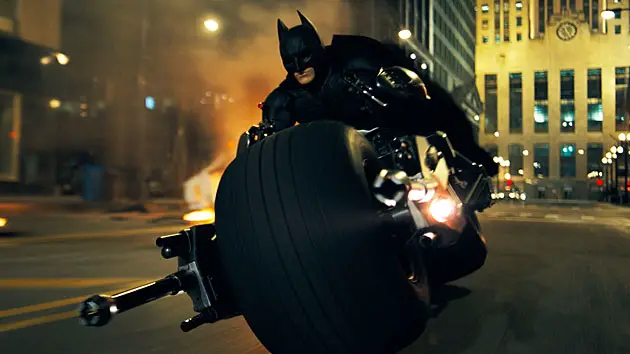
The Bonus Features
And… then, alas alack, there are the features which, in and of themselves, are not bad, but were previously released on the Blu-ray edition in 2012. Warner Bros. offers a Blu-ray-only gimmick called “Focus Points” which features Nolan and crew relating how they accomplished the various shots, scenes and sequences in The Dark Knight. For Batman Begins there was a picture-in-picture feature for following the action as it played out in concept, design and execution. The Dark Knight’s short discussions on the film’s effects, IMAX shooting and other making-of tidbits can be viewed separate from the film or integrated into the film (an icon prompts for playback during the feature). Now, there is a fair amount of material here, but nothing that wouldn’t be more enhanced by a full commentary from Nolan, cast and crew. Additionally, there’s the fact that some of this stuff shows up in the pop-psychology and Bat-tech features. Nevertheless, this is the only place to really hear the players remark on their work. For the record, you’ll hear director Christopher Nolan, producers Emma Thomas, Kevin De La Noy, Charles Roven, special effects supervisor Chris Corbould, production designer Nathan Crowley, DP Wally Pfister, and composers Hans Zimmer and James Newton Howard among others integral to bringing DC’s Caped Crusader to the screen.
Blu-ray Movie with Focus Points
- Gotham Uncovered: Creation of a Scene – Director Christopher Nolan and Creative Collaborators unmask the incredible detail and planning behind the film, including stunt staging, filming in IMAX, the Batsuit and Bat-pod, and more.
Special Features
- Batman Tech – The incredible gadgets and tools
- Batman Unmasked: The Psychology of The Dark Knight – Delve into the psyche of Bruce Wayne and the World of Batman through real-world psychotherapy
- Gotham Tonight – 6 episodes of Gotham Cable’s premiere news program
- The Galleries – The Joker Cards, concept art, poster art, production stills, trailers, & TV spots
“Batman Tech” offers much of what Focus Points had (Heyyyyy!) and features nearly an hour of Nolan and crew discussing those awesome IMAX scenes, controlled demolition stunts, the truck flip (big f’in piston!), the miniature unit and the new Batsuit and Batpod concepts among other small tastes of what production was like on and off set. The other documentary, “Batman Unmasked” is a slightly silly affair that, while offering some basic interesting analysis of Batman and his significant other, Joker, really doesn’t plunge the depths of their relationship and respective origins beyond what most of us already know of them and other comic icons. This is something you’d expect to see as infotainment on cable prior to the film’s theatrical release. Meh.
Worse are the full-length segments of the faux tabloid news show “Gotham Tonight,” featuring Anthony Michael Hall. While they’re interesting in context to the film’s narrative (and Hall’s not bad), they don’t offer much for cinephiles or Batfanatics in regards to how the film was accomplished and the impact it is already starting to have in cinema and fan circles. Nolan created a phenomenon in the summer of 2008 and that is something that bears more focus than the features offered here. Still Galleries also feature the amazing concept art and fantastic PR materials that preceded the film’s release as well as Theatrical and TV trailer spots in from the film in full HD (1 teaser, 2 trailers, and a few TV spots) that are impressive in look and execution.
Conclusion
All-in-all, this 4k Ultra HD Blu-ray release is definitely worth the $24.99 (as are the other two ‘Dark Knight Trilogy’ titles) given the superior image attainable through an Ultra HD Blu-ray player and 4k HDR TV. First editions of the 4k editions sold out almost immediately, but new editions are available from Amazon and other retailers. The Dark Knight Trilogy is also worth checking out as it contains all three films on 4k Blu-ray and Blu-ray.
Scores
Movie
4/5
Video
4/5
Audio
5/5
Bonus Material
3/5
Film review by Christian Hokenson with contributions from HD Report authors. Note: This review has been updated with revisions.
